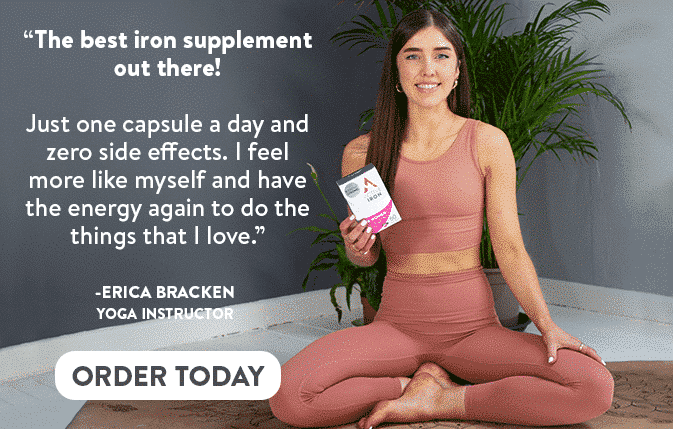HOW MUCH IRON PER DAY FOR A WOMAN?

- Iron supplements for blood donors
- Oral iron supplements
- Do Iron Supplements Cause Constipation?
- Iron supplements for athletes
- The best iron supplements for vegetarians
- The best iron supplement for sensitive stomach
- Benefits of iron for your immune system
- How to take iron supplements for best absorption?
- What does iron saturation mean?
- What is the Function of Iron in our Bodies?
- Iron supplement side effects
- How Much Iron Per Day for a Woman?
Iron is an essential mineral, meaning our bodies need it for optimal health. However, iron is not produced by the body and that is why it’s important to get enough iron from our diet on a daily basis. Inadequate iron levels is a global problem affecting 2 billion people worldwide, with 1 in 4 women impacted. A woman’s iron needs change over her lifetime with menstruating women, endurance athletes, pregnant and postpartum women having a greater need for iron.
In this guide we will answer all your questions related to iron for women, including:
- the benefits of iron for women
- how much iron women need
- iron needs during pregnancy and lactation
- how much iron a woman needs while menstruating
- how much iron a woman needs while exercising
- why women need more iron than men
- should women take iron supplements
- how much iron is safe for a woman
- is it OK for women to take an iron supplement every day
Iron benefits for women
Iron is perhaps best known for its key role in oxygen transportation. Besides oxygen transportation, iron supports cognitive function, the proper functioning of our immune systems and helps our bodies produce energy and reduces tiredness and fatigue.
How much iron do women need?
How much iron a woman needs changes throughout her life. Research shows that women of childbearing age need up to 2X more daily iron than men. Before menstruation starts and post menopause the daily intake for females and males are the same.
In the EU, the recommended minimum nutritional daily intake or NRV is 14mg. However these recommendations vary in the UK and US.
The US Department of Health has set out the following recommended daily allowance (RDA) depending on age.
| AGE | FEMALE | PREGNANCY | BREASTFEEDING |
| 9-13 years | 8 mg | ||
| 14-18 year | 15 mg | 27 mg | 10 mg |
| 19-50 years | 18 mg | 27 mg | 9 mg
|
| 51+ years | 8 mg |
According to the British Dietetic Association and the NHS (UK National Health Services) has set out the following daily recommended intake values for females and males over 11.
| AGE | FEMALE | PREGNANCY | BREASTFEEDING |
| 11-18 year | 14.8 mg | 14.8 mg | 14.8 mg |
| 19-50 years | 14.8 mg | 14.8 – 30 mg* | 14.8 mg |
| 51+ years | 8.7 mg |
How much iron does a woman need while pregnant?
During pregnancy, the amount of blood in your body increases by 30-50%. This increases the requirement for iron in your body as it’s needed to make haemoglobin, which carries oxygen to other cells in your body.
The NHS recommends a daily iron intake for pregnant women of 14mg -30mg, with as much as 30mg required per day required in the second and third trimester.
Your iron needs during pregnancy and lactation
Research shows that many women do not have sufficient iron in their diet to meet their daily needs. This is also true during pregnancy, especially during the second and third trimesters when dietary iron requirements increase.
Breastfeeding mothers also provide their babies with the iron needed for their growth & development. Lactation also increases your daily iron needs. You’ll need at least 9mg of iron every day, however for some women postpartum their needs may be higher.
How much iron does a woman need while menstruating?
Monthly periods are the most common cause of iron loss for women. It is estimated that 220 to 250mg of iron per pint of blood is lost during menstruation. According to UK government research (National Diet and Nutrition Survey 2016), almost half the girls aged 11 to 18, and more than a quarter of women aged 19 to 64 in the UK are not getting the minimum intakes of iron recommended for good health.
How much iron does a woman need while exercising?
During exercise your muscles require iron for energy production and oxygen transport. Adequate iron is particularly important for those who exercise regularly or for women who enjoy endurance exercise such as running, rowing and cycling. Sweating during intense exercise, can lead to further iron loss in the body.
Why women need more iron than men
Getting the right amount of iron is crucial to the physical health and mental performance of men and women. Women lose an additional amount due to monthly menstruation and have an increased need for iron during pregnancy and breastfeeding.
Should women take iron supplements?
There are a large variety of reasons why women may not be able to meet their daily iron needs through diet alone including
- Periods/menstruation
- Pregnant, lactating and postpartum women
- People who follow specific diets e.g. vegetarians,
- Avid exercisers e.g. runners, cyclists and endurance athletes.
- Blood donors.
If your iron intake is lower than your iron use, then you may benefit from adding an iron supplement to your daily routine. However, food supplements are not a substitute for a varied diet and a healthy lifestyle.
Gentle iron supplements for women
Iron supplements offer a great solution for those who struggle to meet their iron requirements through diet alone. However, not all iron supplements are created equally. Women have been putting up with the side effects of iron supplements for too long, with 8 out of 10 people³ reporting side effects such as nausea, constipation and diarrhoea.
Active Iron is different.
We have developed a ground-breaking new method of delivering iron that helps reduce the common side effects women often experience from iron supplementation. Active Iron has 2X better absorption of iron sulfate and is 6X less likely to cause gut irritation⁵ compared to other iron supplements, making it both Kind & Strong.
How much iron for women: FAQ
In this section, we answer some of the questions women frequently ask about why iron is important, how it increases dietary iron levels, and how to supplement with iron without feeling sick or experiencing constipation.
Why do women need iron?
Women’s bodies rely on iron in order to support several key functions, including maintaining energy levels, and transporting oxygen via red blood cells. Iron also plays a key role in supporting our immune system & cognitive function, and insufficient iron levels can leave a person feeling fatigued.
How can I increase iron in my diet?
There are two types of iron found in the diet, non-haem iron and haem iron. Non-haem iron is found in plants, nuts and legumes. This is absorbed at a much lower rate and extent than heme iron, which is found in animal products such as meat, especially red meat. It’s important to remember that even if you are making a conscious effort to increase your heme iron intake by eating meat, other daily habits like drinking tea and coffee with or directly after your meals can reduce iron absorption.
How can I supplement with iron without experiencing unwanted side effects?
Active Iron is 6X less likely to cause gut irritation⁵ compared to other iron supplements, meaning it’s kind on your stomach. Active Iron’s ground-breaking protein formula targets the body’s natural site of iron absorption, the DMT-1, increasing the amount of iron absorbed.
How much iron is safe for a woman?
In the EU, the recommended minimum nutritional daily intake or NRV for iron is 14mg. The amount of iron required by pregnant women can be as much as 30mg per day. If you have questions about the right level of iron for you, please speak to your healthcare professional.
Is 50mg iron too much for a woman?
A woman may not need this quantity routinely but might require this for a period of time to achieve optimal iron levels. Once iron levels return to optimal levels, and storage levels are healthy again, your recommended iron intake levels may be reduced. Before increasing your daily intake of iron to 50mg or more, please consult a healthcare professional.
Is it OK for women to take an iron supplement every day?
NHS guidelines state that taking 17 mg or less a day of iron supplements is unlikely to cause any harm.
There is a condition called haemochromatosis (iron overload) that is inherited, and iron levels build up slowly over many years. Diagnosis of this is through genetic screening.
We recommend Active Iron only to those who are at risk of developing inadequate iron levels (i.e those with regular periods, pregnant, vegetarians, heavy exercisers) or have known inadequate iron levels. Remember, food supplements are not a substitute for a varied diet and a healthy lifestyle.
How much iron should a woman take daily?
A woman’s daily iron intake may change over time, in the EU the NRV is 14mg per day, however women with periods, pregnant or breastfeeding women and active exercises may have an increased iron need. A woman’s body will naturally increase its iron absorption in times of blood loss.
How much Iron per day for a woman is needed: Conclusion
Women’s iron needs change over time. Menstruating women have a higher need for iron due to monthly blood loss. During pregnancy, a woman’s blood volume increases and so there is an additional need for iron. It is also recommended that breastfeeding women increase their iron intake. Following menopause, your iron needs decrease significantly.
Active exercisers may also need additional iron as iron can be lost in sweat.
It is important to choose an iron supplement that is well absorbed. If you want to increase your iron intake without unwanted side effects, choose an iron that is gentle on your stomach.
Active Iron’s non-constipating formula helps avoid gut irritation from iron and is clinically proven to deliver 2X better absorption of iron sulfate, making it both Kind & Strong.

